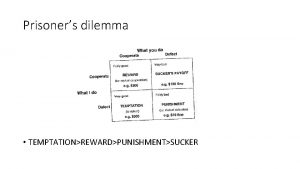GAME THEORY THE PRISONERS DILEMMA GAME THEORY Game






- Slides: 6

GAME THEORY & THE PRISONER’S DILEMMA

GAME THEORY � � Game theory is used to explain how 2 or more players make decisions or choose actions when their actions (or strategies) affect each participant. Each player determines his or her best response to the possible actions of every other player. According to game theory, a player’s choice of strategy depends on the strategy the player thinks other players will choose. In some cases, these strategies reinforce each other, but in other cases, they do not.

WHY IS GAME THEORY IMPORTANT? � provides insights into how business & govt decisions are made & has numerous realworld applications. � i. e. game theory has helped economists analyze antitrust policy, tariff wars & auctioning behavior.

NASH EQUILLIBRIUM � When the chosen strategies reinforce each other, the game achieves what is called a Nash Equilibrium. The Nash Equilibrium is named after John F. Nash, Jr. , who was cowinner of the 1994 Nobel Prize in Economics for his work in this area and the subject of the 2001 movie A Beautiful Mind.

GAME THEORY � � � The 3 Basic Elements of Game Theory: � the players � the strategies available to each player � the payoffs each player receives Payoff Matrix: Summarizes the 3 items above Example: Coke vs. Pepsi and & advertising � 2 players: Coke, Pepsi � 2 strategies: advertise/don’t advertise � Payoffs: Advertise- 80, 120, 45 � Payoffs: Don’t advertise- 45, 120 100, 100 � Pepsi, as the row player, can choose either Advertise or Don’t Advertise. � Coke, as the column player, can choose either Advertise or Don’t Advertise.

GAME THEORY CONT. � The 1 st number in each square refers to the payoff for the row (horizontal) player, here Pepsi. � The 2 nd number in each square refers to the payoff for the column (vertical) player, here Coke. � The numbers represent the profit for Pepsi & Coke.











